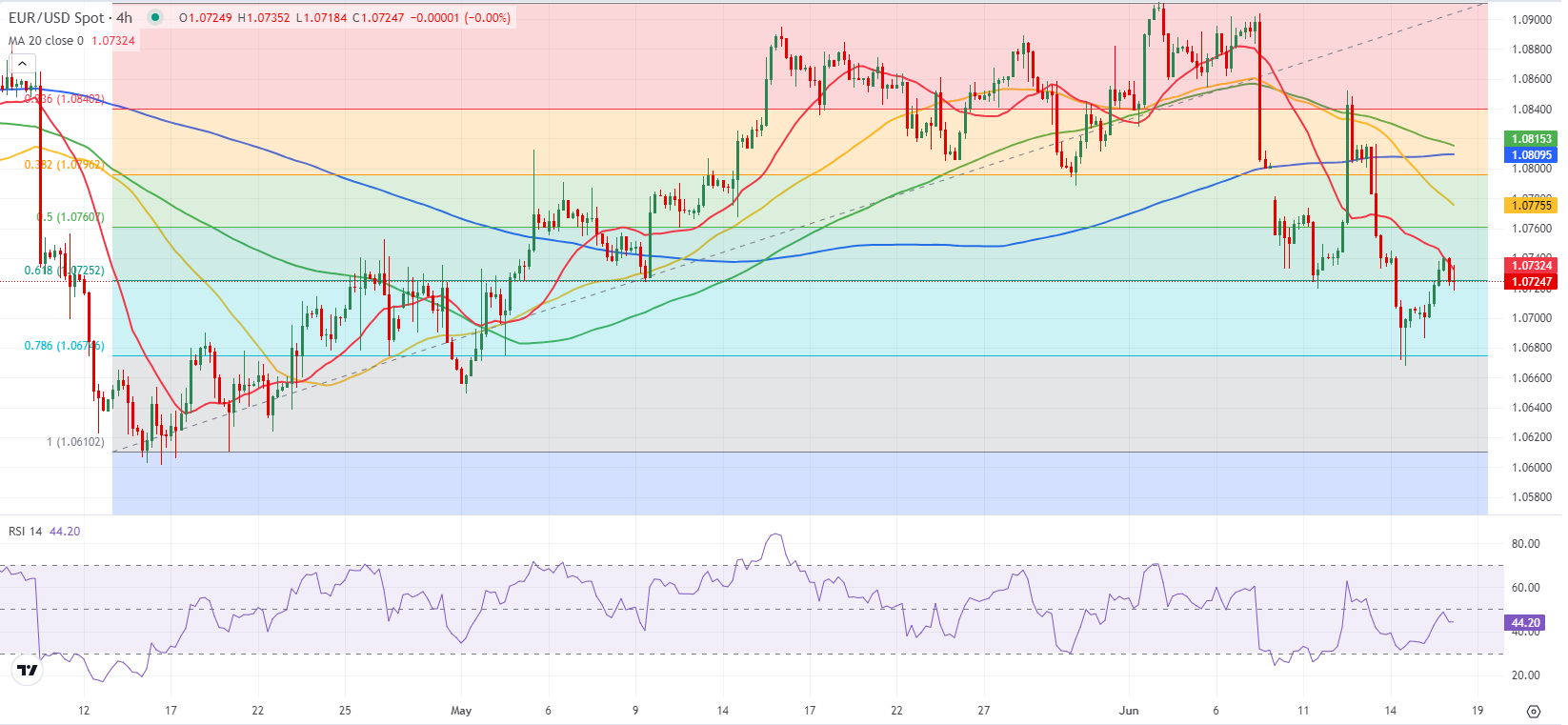Products You May Like
- EUR/USD holds steady above 1.0700 after posting gains on Monday.
- The pair could stretch higher in case risk flows dominate the action in financial markets.
- US economic docket will feature Retail Sales data for May.
After struggling to gain traction in the first half of the day on Monday, EUR/USD turned north in the American session and closed in positive territory. The pair stays relatively quiet early Tuesday and fluctuates in a tight channel above 1.0700.
Euro PRICE This week
The table below shows the percentage change of Euro (EUR) against listed major currencies this week. Euro was the strongest against the New Zealand Dollar.
| USD | EUR | GBP | JPY | CAD | AUD | NZD | CHF | |
|---|---|---|---|---|---|---|---|---|
| USD | -0.18% | 0.05% | 0.47% | 0.00% | -0.03% | 0.49% | -0.20% | |
| EUR | 0.18% | 0.25% | 0.68% | 0.21% | 0.06% | 0.72% | -0.02% | |
| GBP | -0.05% | -0.25% | 0.52% | -0.04% | -0.21% | 0.43% | -0.25% | |
| JPY | -0.47% | -0.68% | -0.52% | -0.35% | -0.49% | 0.16% | -0.61% | |
| CAD | -0.01% | -0.21% | 0.04% | 0.35% | -0.10% | 0.49% | -0.19% | |
| AUD | 0.03% | -0.06% | 0.21% | 0.49% | 0.10% | 0.72% | -0.04% | |
| NZD | -0.49% | -0.72% | -0.43% | -0.16% | -0.49% | -0.72% | -0.68% | |
| CHF | 0.20% | 0.02% | 0.25% | 0.61% | 0.19% | 0.04% | 0.68% |
The heat map shows percentage changes of major currencies against each other. The base currency is picked from the left column, while the quote currency is picked from the top row. For example, if you pick the Euro from the left column and move along the horizontal line to the US Dollar, the percentage change displayed in the box will represent EUR (base)/USD (quote).
In the absence of high-tier data releases, the positive shift seen in risk mood, as reflected by rising US stocks, made it difficult for the US Dollar (USD) to find demand in the American session and provided a boost to the pair.
Early Tuesday, the Euro Stoxx 50 Index is up more than 0.5% and US stock index futures trade marginally higher on the day.
In the second half of the day, the US Census Bureau will release Retail Sales data for May. Markets expect a monthly increase of 0.2%. A bigger-than-expected growth could support the USD with the immediate reaction, while a negative print could weigh on the currency and help EUR/USD stretch higher.
Investors will continue to pay close attention to risk perception. A bullish opening in Wall Street, followed by an extended rally, could hurt the USD.
During the American trading hours, several Federal Reserve policymakers will be delivering speeches. In case officials continue to push back against the market expectation for a policy pivot in September, the USD could stay resilient and limit EUR/USD’s upside.
EUR/USD Technical Analysis
The Relative Strength Index (RSI) indicator on the 4-hour chart stays below 50, suggesting that the pair is yet to gather bullish momentum. In case the pair manages to hold above .10730, where the Fibonacci 61.8% retracement of the latest uptrend is located, 1.0760 (Fibonacci 50% retracement) and 1.0800 (Fibonacci 38.2% retracement) could be seen as next resistance levels.
On the downside, 1.0670 (Fibonacci 78.6% retracement) aligns as key support before 1.0600 (beginning point of the uptrend).
Euro FAQs
The Euro is the currency for the 20 European Union countries that belong to the Eurozone. It is the second most heavily traded currency in the world behind the US Dollar. In 2022, it accounted for 31% of all foreign exchange transactions, with an average daily turnover of over $2.2 trillion a day. EUR/USD is the most heavily traded currency pair in the world, accounting for an estimated 30% off all transactions, followed by EUR/JPY (4%), EUR/GBP (3%) and EUR/AUD (2%).
The European Central Bank (ECB) in Frankfurt, Germany, is the reserve bank for the Eurozone. The ECB sets interest rates and manages monetary policy. The ECB’s primary mandate is to maintain price stability, which means either controlling inflation or stimulating growth. Its primary tool is the raising or lowering of interest rates. Relatively high interest rates – or the expectation of higher rates – will usually benefit the Euro and vice versa. The ECB Governing Council makes monetary policy decisions at meetings held eight times a year. Decisions are made by heads of the Eurozone national banks and six permanent members, including the President of the ECB, Christine Lagarde.
Eurozone inflation data, measured by the Harmonized Index of Consumer Prices (HICP), is an important econometric for the Euro. If inflation rises more than expected, especially if above the ECB’s 2% target, it obliges the ECB to raise interest rates to bring it back under control. Relatively high interest rates compared to its counterparts will usually benefit the Euro, as it makes the region more attractive as a place for global investors to park their money.
Data releases gauge the health of the economy and can impact on the Euro. Indicators such as GDP, Manufacturing and Services PMIs, employment, and consumer sentiment surveys can all influence the direction of the single currency. A strong economy is good for the Euro. Not only does it attract more foreign investment but it may encourage the ECB to put up interest rates, which will directly strengthen the Euro. Otherwise, if economic data is weak, the Euro is likely to fall. Economic data for the four largest economies in the euro area (Germany, France, Italy and Spain) are especially significant, as they account for 75% of the Eurozone’s economy.
Another significant data release for the Euro is the Trade Balance. This indicator measures the difference between what a country earns from its exports and what it spends on imports over a given period. If a country produces highly sought after exports then its currency will gain in value purely from the extra demand created from foreign buyers seeking to purchase these goods. Therefore, a positive net Trade Balance strengthens a currency and vice versa for a negative balance.

